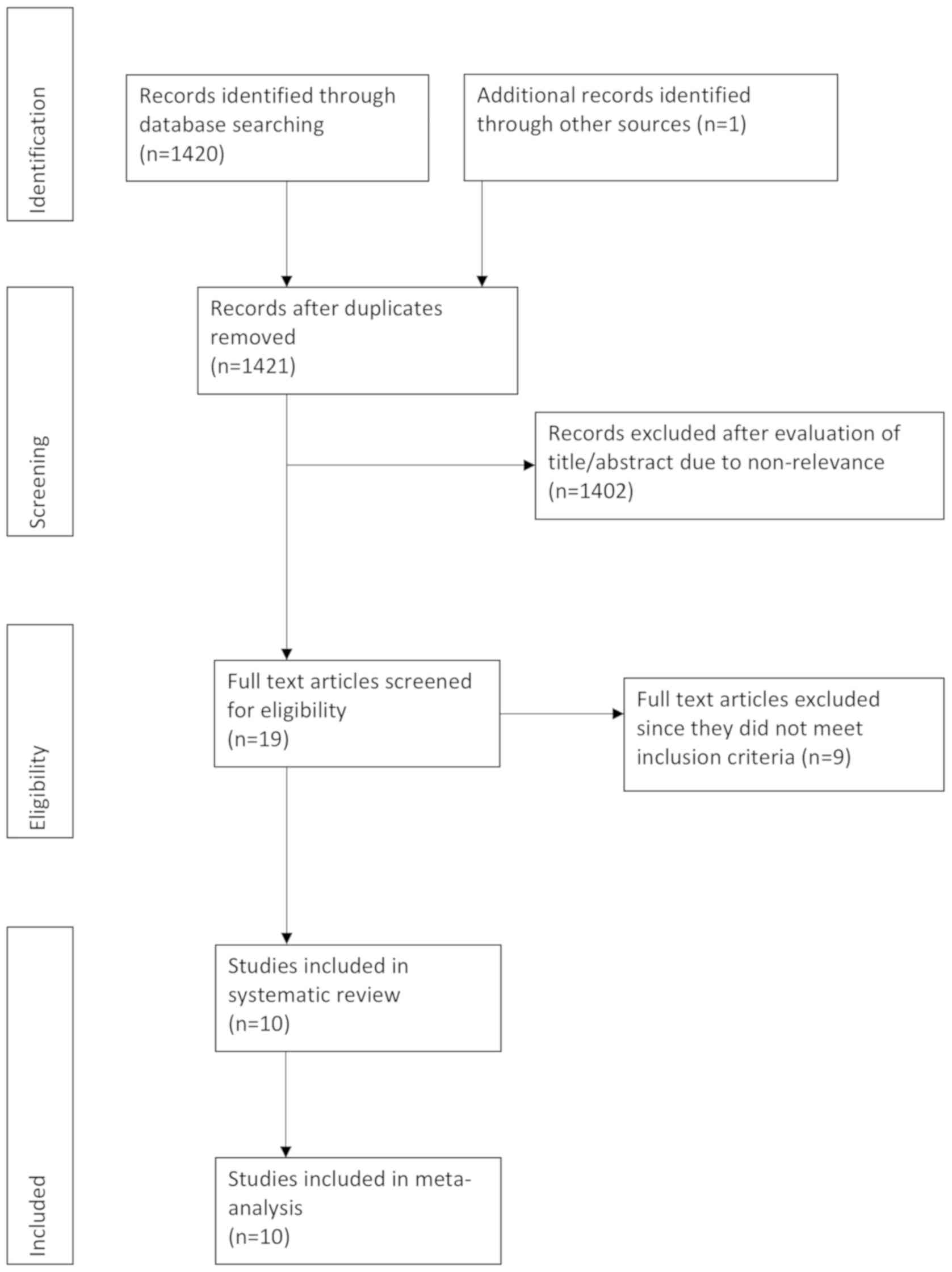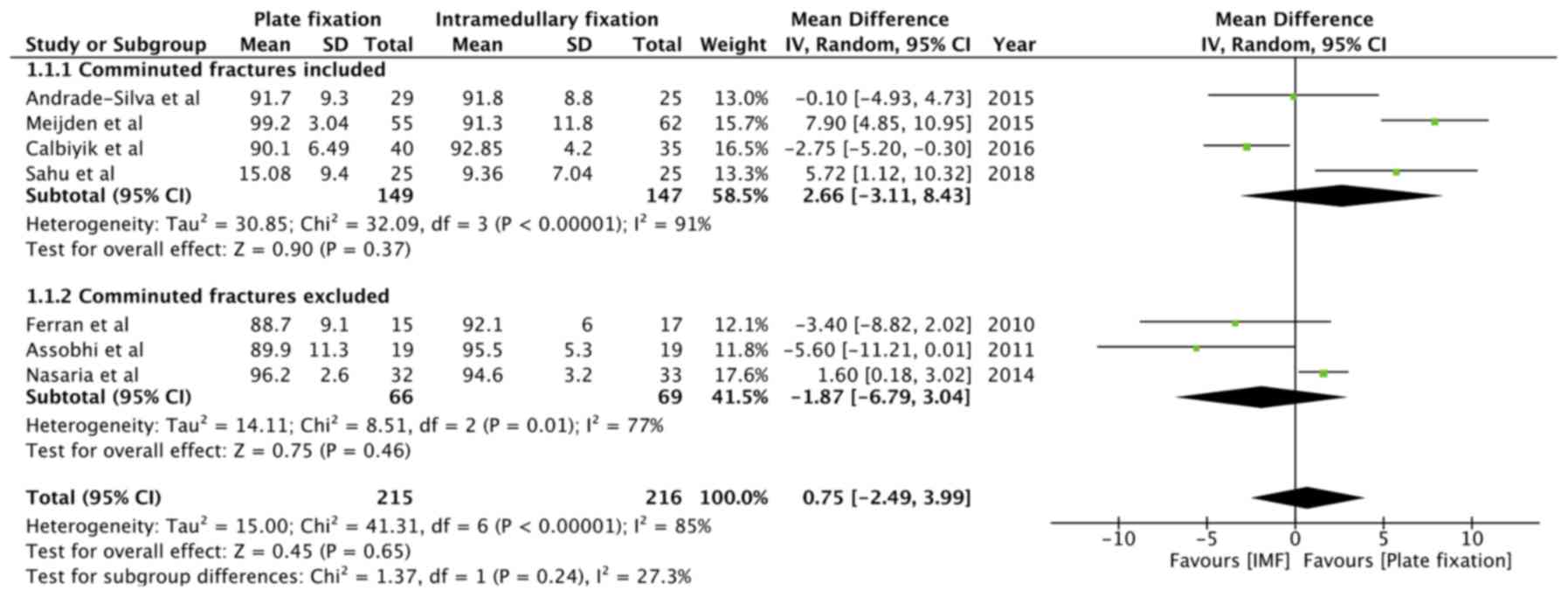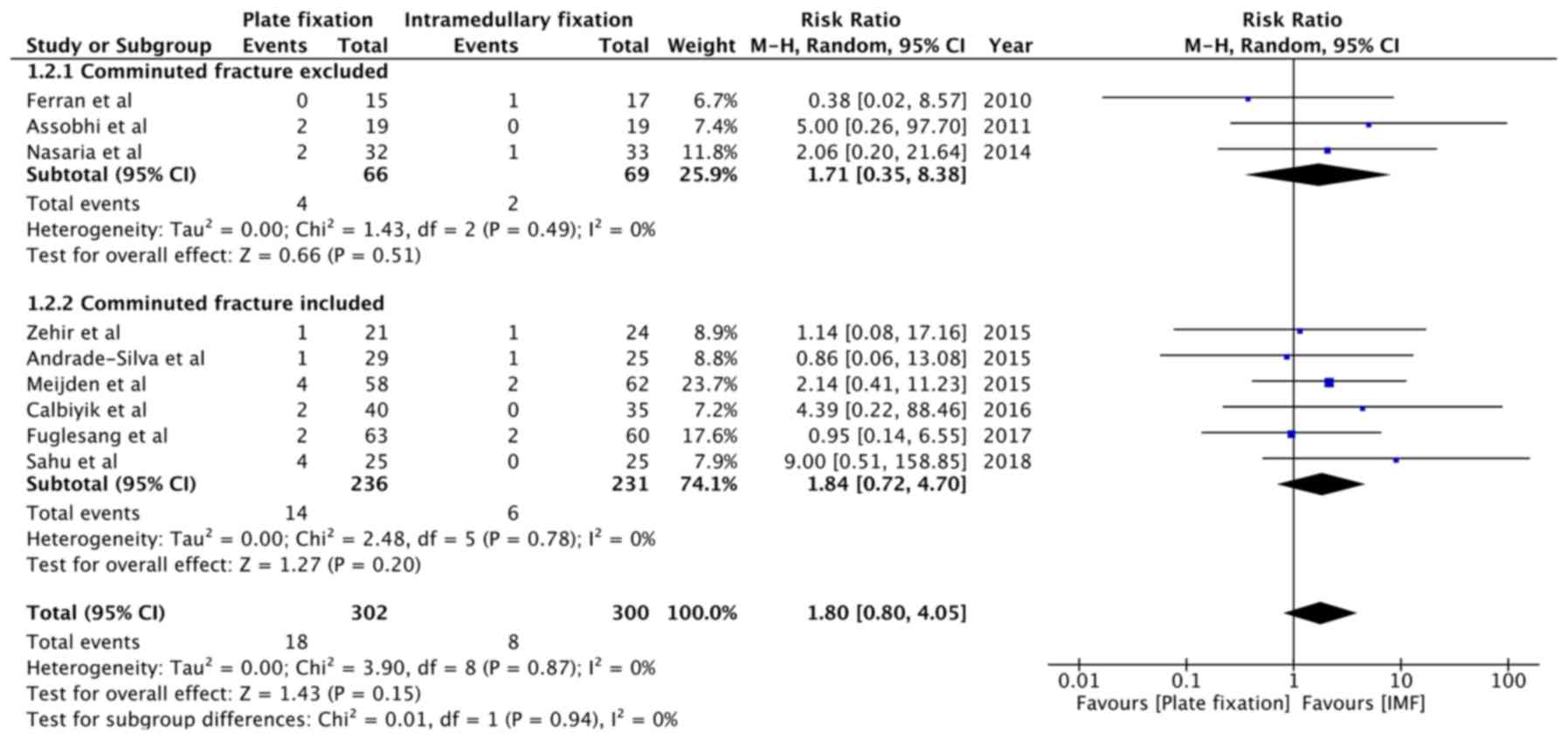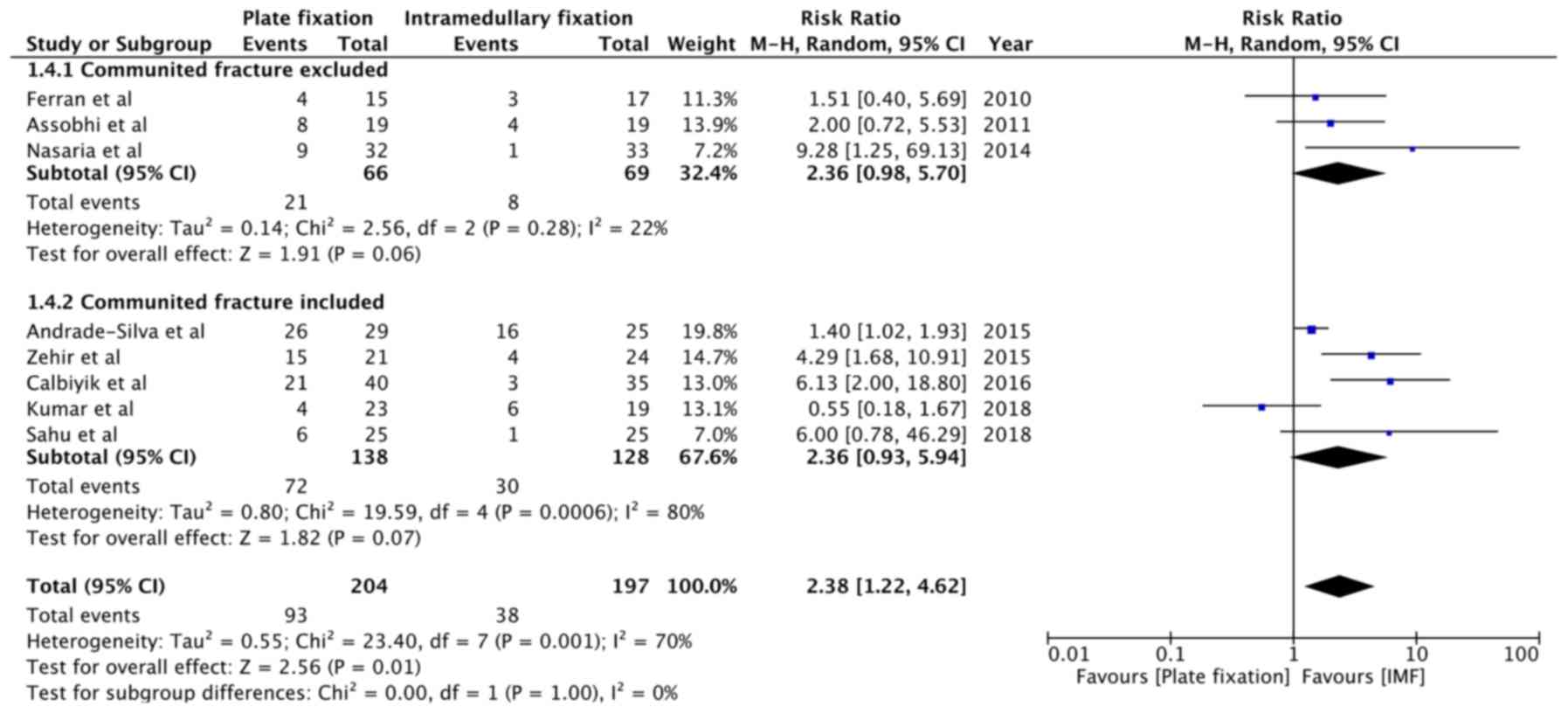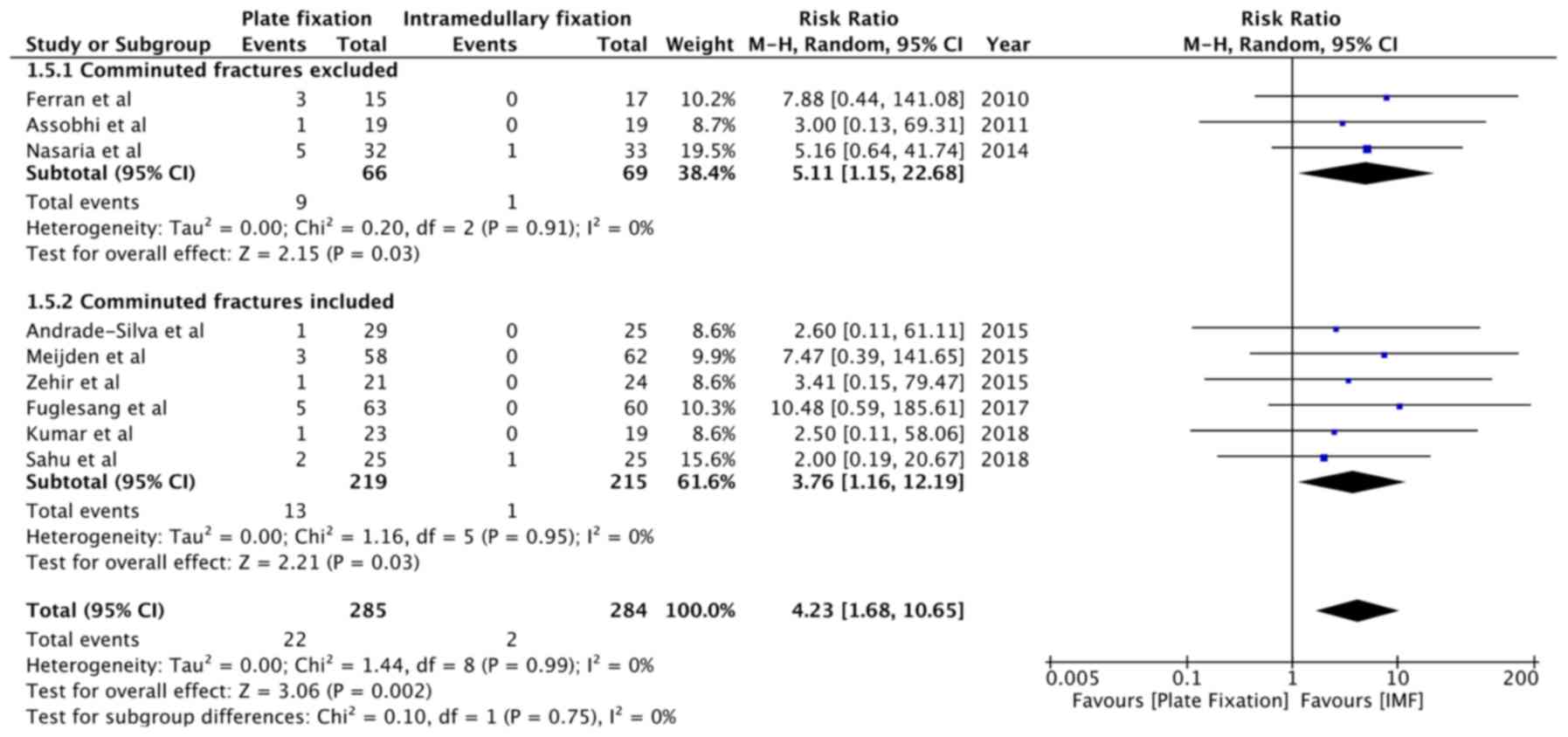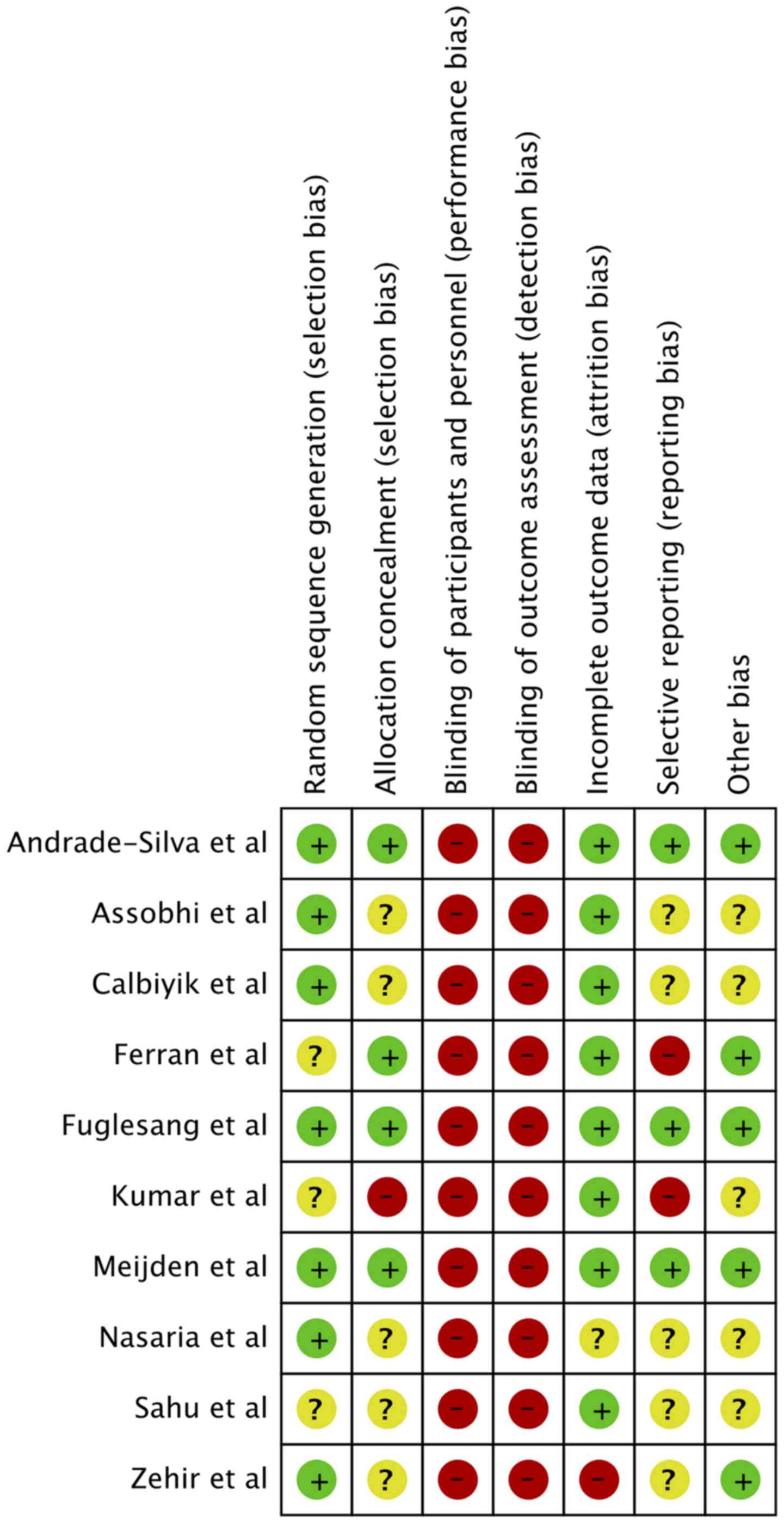|
1
|
Robinson CM: Fractures of the clavicle in
the adult Epidemiology and classification. J Bone Joint Surg Br.
80:476–84. 1998.PubMed/NCBI View Article : Google Scholar
|
|
2
|
Nordqvist A and Petersson C: The incidence
of fractures of the clavicle. Clin Orthop Relat Res. 300:127–132.
1994.PubMed/NCBI
|
|
3
|
Postacchini F, Gumina S, De Santis P and
Albo F: Epidemiology of clavicle fractures. J Shoulder Elb Surg.
11:452–456. 2002.PubMed/NCBI View Article : Google Scholar
|
|
4
|
CS NEER II: Nonunion of the clavicle. J Am
Med Assoc. 172:1006–1011. 1960.PubMed/NCBI View Article : Google Scholar
|
|
5
|
Smekal V, Irenberger A, Struve P,
Wambacher M, Krappinger D and Kralinger FS: Elastic stable
intramedullary nailing versus nonoperative treatment of displaced
midshaft clavicular fractures-a randomized, controlled, clinical
trial. J Orthop Trauma. 23:106–112. 2009.PubMed/NCBI View Article : Google Scholar
|
|
6
|
Xu B, Lin Y, Wang Z, Cao J, Yang Y, Xia H
and Zhang Y: Is intramedullary fixation of displaced midshaft
clavicle fracture superior to plate fixation? Evidence from a
systematic review of discordant meta-analyses. Int J Surg.
43:155–162. 2017.PubMed/NCBI View Article : Google Scholar
|
|
7
|
Wijdicks F-JG, Van der Meijden OAJ,
Millett PJ, Verleisdonk EJMM and Houwert RM: Systematic review of
the complications of plate fixation of clavicle fractures. Arch
Orthop Trauma Surg. 132:617–625. 2012.PubMed/NCBI View Article : Google Scholar
|
|
8
|
Wijdicks FJ, Houwert RM, Millett PJ,
Verleisdonk EJ and Van der Meijden OA: Systematic review of
complications after intramedullary fixation for displaced midshaft
clavicle fractures. Can J Surg. 56:58–64. 2013.PubMed/NCBI View Article : Google Scholar
|
|
9
|
Houwert RM, Smeeing DPJ, Ahmed Ali U,
Hietbrink F, Kruyt MC and van der Meijden OA: Plate fixation or
intramedullary fixation for midshaft clavicle fractures: A
systematic review and meta-analysis of randomized controlled trials
and observational studies. J Shoulder Elb Surg. 25:1195–1203.
2016.
|
|
10
|
Zhu Y, Tian Y, Dong T, Chen W, Zhang F and
Zhang Y: Management of the mid-shaft clavicle fractures using plate
fixation versus intramedullary fixation: An updated meta-analysis.
Int Orthop. 39:319–328. 2015.PubMed/NCBI View Article : Google Scholar
|
|
11
|
Gao Y, Chen W, Liu YJ, Li X, Wang HL and
Chen ZY: Plating versus intramedullary fixation for mid-shaft
clavicle fractures: A systemic review and meta-analysis. PeerJ.
4(e1540)2016.PubMed/NCBI View Article : Google Scholar
|
|
12
|
Zhang B, Zhu Y, Zhang F, Chen W, Tian Y
and Zhang Y: Meta-analysis of plate fixation versus intramedullary
fixation for the treatment of mid-shaft clavicle fractures. Scand J
Trauma Resusc Emerg Med. 23(27)2015.PubMed/NCBI View Article : Google Scholar
|
|
13
|
Wang XH, Cheng L, Guo WJ, Li AB, Cheng GJ,
Lei T and Zhao YM: Plate versus intramedullary fixation care of
displaced midshaft clavicular fractures: A meta-analysis of
prospective randomized controlled trials. Medicine (Baltimore).
94(e1792)2015.PubMed/NCBI View Article : Google Scholar
|
|
14
|
Calbiyik M, Ipek D and Taskoparan M:
Prospective randomized study comparing results of fixation for
clavicular shaft fractures with intramedullary nail or locking
compression plate. Int Orthop. 41:173–179. 2017.PubMed/NCBI View Article : Google Scholar
|
|
15
|
Fuglesang HFS, Flugsrud GB, Randsborg PH,
Oord P, Benth J and Utvåg SE: Plate fixation versus intramedullary
nailing of completely displaced midshaft fractures of the clavicle.
Bone Joint J. 99:1095–1101. 2017.PubMed/NCBI View Article : Google Scholar
|
|
16
|
Constant CR and Murley AH: A clinical
method of functional assessment of the shoulder. Clin Orthop Relat
Res. 160–164. 1987.PubMed/NCBI
|
|
17
|
Hudak PL, Amadio PC and Bombardier C:
Development of an upper extremity outcome measure: The DASH
(disabilities of the arm, shoulder and hand) [corrected]. The upper
extremity collaborative group (UECG). Am J Ind Med. 29:602–608.
1996.PubMed/NCBI View Article : Google Scholar
|
|
18
|
Hussain N, Sermer C, Prusick PJ, Banfield
L, Atrey A and Bhandari M: Intramedullary nailing versus plate
fixation for the treatment displaced midshaft clavicular fractures:
A systematic review and meta-analysis. Sci Rep.
6(34912)2016.PubMed/NCBI View Article : Google Scholar
|
|
19
|
Higgins J, Altman D and Sterne J: Cochrane
statistical methods group and the cochrane bias methods group.
Chapter 8: Assessing risk of bias in included studies. In: Cochrane
handbook for systemic reviews of interventions, version 5. The
Cochrane Collaboration, 2011.
|
|
20
|
Lee YS, Lin CC, Huang CR, Chen CN and Liao
WY: Operative treatment of midclavicular fractures in 62 elderly
patients: Knowles pin versus plate. Orthopedics. 30:959–964.
2007.PubMed/NCBI View Article : Google Scholar
|
|
21
|
Tabatabaei S and Shalamzari S: Treatment
of displaced midshaft clavicular fractures: A comparison between
smooth pin and LCDCP and reconstruction plate fixation. Pakistan J
Med Sci. 27:1129–1134. 2011.
|
|
22
|
Saha P, Datta P, Ayan S, Garg A,
Bandyopadhyay U and Kundu S: Plate versus titanium elastic nail in
treatment of displaced midshaft clavicle fractures A comparative
study. Indian J Orthop. 48:587–593. 2014.PubMed/NCBI View Article : Google Scholar
|
|
23
|
Krishnan A, Barot MP, Dave BR, Bang P,
Devanand D, Patel D and Jain A: Percutaneous transforaminal
endoscopic decompression and cageless percutaneous bone graft
transforaminal lumbar interbody fusion: A feasibility study. J
Orthop Allied Sci. 6:21–27. 2018.
|
|
24
|
Kumar R, Kumar S, Singh D and Goel SC:
Role of bone marrow derived autologous mesenchymal stem cells in
fracture healing in rabbits. JBJD. 32:7–13. 2017.
|
|
25
|
Balachandar S, Mohankumar K and Kathir AS:
Outcome of plate and intramedullary fixation of midshaft clavicle
fractures: A search for optimal surgical management. Int J Orthop
Sci. 3:1050–1061. 2017.
|
|
26
|
Kingsly P, Sathish M and Ismail NDM:
Comparative analysis of functional outcome of anatomical
precontoured locking plate versus reconstruction plate in the
management of displaced midshaft clavicular fractures. J Orthop
Surg (Hong Kong). 27(2309499018820351)2019.PubMed/NCBI View Article : Google Scholar
|
|
27
|
Hulsmans MHJ, van Heijl M, Houwert RM,
Hammacher ER, Meylaerts SA, Verhofstad MH, Dijkgraaf MG and
Verleisdonk EJ: High irritation and removal rates after plate or
nail fixation in patients with displaced midshaft clavicle
fractures. Clin Orthop Relat Res. 475:532–539. 2017.PubMed/NCBI View Article : Google Scholar
|
|
28
|
Assobhi JEH: Reconstruction plate versus
minimal invasive retrograde titanium elastic nail fixation for
displaced midclavicular fractures. J Orthop Traumatol. 12:185–192.
2011.PubMed/NCBI View Article : Google Scholar
|
|
29
|
Narsaria N, Singh AK, Arun GR and Seth
RRS: Surgical fixation of displaced midshaft clavicle fractures:
Elastic intramedullary nailing versus precontoured plating. J
Orthop Traumatol. 15:165–171. 2014.PubMed/NCBI View Article : Google Scholar
|
|
30
|
Van Der Meijden OA, Marijn Houwert R,
Hulsmans M, Wijdicks FJ, Dijkgraaf MG, Meylaerts SA, Hammacher ER,
Verhofstad MH and Verleisdonk EJ: Operative treatment of dislocated
midshaft clavicular fractures: Plate or intramedullary nail
fixation?: A randomized controlled trial. J Bone Joint Surg Am.
97:613–619. 2015.PubMed/NCBI View Article : Google Scholar
|
|
31
|
Zehir S, Zehir R, Şahin E and Çalbıyık M:
Comparison of novel intramedullary nailing with mini-invasive
plating in surgical fixation of displaced midshaft clavicle
fractures. Arch Orthop Trauma Surg. 135:339–344. 2015.PubMed/NCBI View Article : Google Scholar
|
|
32
|
Kumar DM, Mishra DA, Kumar DD, Singh DA,
Pandey DD and Sinha DAK: A comparative study of displaced midshaft
clavicle fracture managed by precontoured locking compression
plates and titanium elastic nails. Int J Orthop Sci. 4:116–121.
2018.
|
|
33
|
Sahu AK, Lenka BS, Mishra AK, Panda CK and
Kar M: A comparative study between plating versus titanium elastic
nail system in mid-shaft clavicle fracture management. Int J Res
Orthop. 4(741)2018.
|
|
34
|
Ferran NA, Hodgson P, Vannet N, Williams R
and Evans RO: Locked intramedullary fixation vs plating for
displaced and shortened mid-shaft clavicle fractures: A randomized
clinical trial. J Shoulder Elb Surg. 19:783–789. 2010.PubMed/NCBI View Article : Google Scholar
|
|
35
|
Andrade-Silva F, Kojima KD, Joeris A,
Silva JS and Rames Mattar Jr: Single, superiorly placed
reconstruction plate compared with flexible intramedullary nailing
for midshaft clavicular fractures: A prospective, randomized
controlled trial. J Bone Joint Surg Am. 97:620–626. 2015.PubMed/NCBI View Article : Google Scholar
|
|
36
|
Xiao H, Gao H, Zheng T, Zhao J and Tian Y:
Plate fixation versus intramedullary fixation for midshaft clavicle
fractures: Meta-analysis of complications and functional outcomes.
J Int Med Res. 44:201–215. 2016.PubMed/NCBI View Article : Google Scholar
|
|
37
|
Lenza M and Faloppa F: Surgical
interventions for treating acute fractures or non-union of the
middle third of the clavicle. Cochrane Database Syst Rev.
7(CD007428)2015.PubMed/NCBI View Article : Google Scholar
|
|
38
|
Duan X, Zhong G, Cen S, Huang F and Xiang
Z: Plating versus intramedullary pin or conservative treatment for
midshaft fracture of clavicle: A meta-analysis of randomized
controlled trials. J Shoulder Elbow Surg. 20:1008–1015.
2011.PubMed/NCBI View Article : Google Scholar
|
|
39
|
Smekal V, Irenberger A, Attal R El,
Oberladstaetter J, Krappinger D and Kralinger F: Elastic stable
intramedullary nailing is best for mid-shaft clavicular fractures
without comminution: Results in 60 patients. Injury. 42:324–329.
2011.PubMed/NCBI View Article : Google Scholar
|
|
40
|
Zeng L, Wei H, Liu Y, Zhang W, Pan Y,
Zhang W, Zhang C, Zeng B and Chen Y: Titanium elastic nail (TEN)
versus reconstruction plate repair of midshaft clavicular
fractures: A finite element study. PLoS One. 10(e0126131)2015.
|
|
41
|
Schemitsch LA, Schemitsch EH, Kuzyk P and
McKee MD: Prognostic factors for reoperation after plate fixation
of the midshaft clavicle. J Orthop Trauma. 29:533–537. 2015.
|
|
42
|
Leroux T, Wasserstein D, Henry P, Khoshbin
A, Dwyer T, Ogilvie-Harris D, Mahomed N and Veillette C: Rate of
and risk factors for reoperations after open reduction and internal
fixation of midshaft clavicle fractures. J Bone Joint Surg Am.
96:1119–1125. 2014.PubMed/NCBI View Article : Google Scholar
|
|
43
|
Canadian Orthopaedic Trauma Society.
Nonoperative treatment compared with plate fixation of displaced
midshaft clavicular fractures. J Bone Joint Surg. 89:1–10.
2007.PubMed/NCBI View Article : Google Scholar
|















